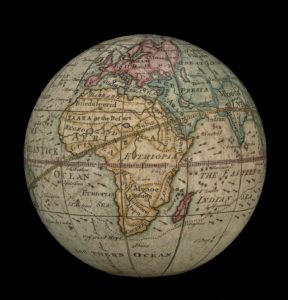
15. R. Cushee and E. Cushee, 1731
A New Globe of the Earth
Smith Collection: SM-1731-5
www.oshermaps.org/map/2322.0001
A New Globe of the Earth (#15) is a pocket globe made by Richard Cushee and his wife, Elizabeth. Richard Cushee originally designed the globe in 1731, and Elizabeth modified it about a decade later.
This little handheld globe shows six continents, all colored distinctly. Due to its size, it lacks remarkable detail. However, Elizabeth added details where she could, including arrows around the globe to represent the trade winds. She also added a dotted line showing George Anson’s voyage around the world.
The most important change that Elizabeth Cushee made was reattaching California to North America. On her husband’s globe, California was depicted as a large island off the coast, but that had since been disproven.
The Cushee pocket globe comes in a fish-skin sleeve. On the interior of the sleeve, the Cushees pasted gores of a concave celestial globe, with the stars oriented as we see them from Earth. They were the first globemakers to achieve this projection successfully.
This pocket globe was created by Richard Cushee, and published with the help of Elizabeth Cushee, his wife. They sold their globes at the Globe and Sun in London. When Richard died in 1733. Elizabeth took over the business and continued to sell the globes they had already created. Richard Cushee worked with John Senex, who created globe #5, and Thomas Wright, related to the creator of globe #1.
There are a couple interesting pieces of this little globe. Most noticeably, the pocket terrestrial globe comes in a sleeve, which has gores of a celestial globe pasted inside. When closed just right, the concave celestial globe could match up with the terrestrial globe it holds. The development of these sleeves is significant because they show the sky and stars as we see them from earth. Most celestial globes show the constellations as we would see them if we were on the edge of the universe looking in on the earth, called an external projection.

This globe also shows California as an island– a common idea at the time of this globe’s creation. It also includes the constellation of the Lynx, which was a new constellation introduced by Johann Hevelius.
This globe has no “southern continent” on it– what we now know as Antarctica. At the time this globe was made, some people believed that there was a giant continent, called Terra Australis, or “unknown land of the south.” To learn more about Terra Australis, you might want to read about the Globe Dresse par M. Robert de Vaugondy on page